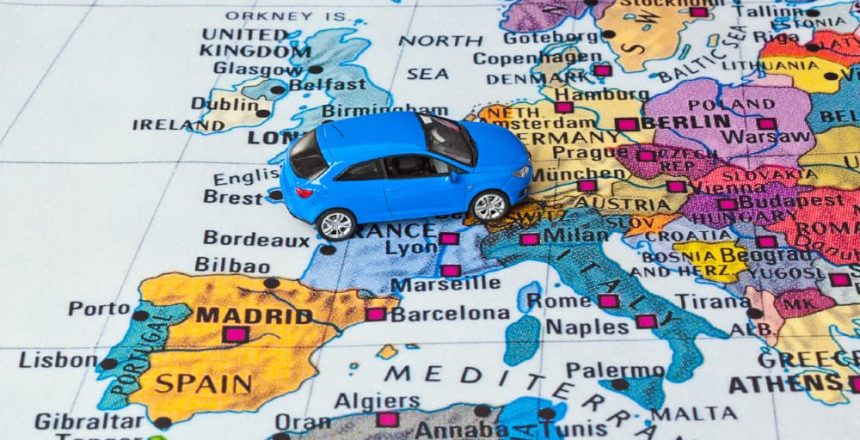Shipping your car to Europe requires several key steps to ensure you obey regional laws and avoid unnecessary expense.
Key Takeaways:
- Shipping your car to Europe might be cheaper than renting a car for months at a time
- You’ll want to figure out logistics before starting the shipping process
- There will be paperwork to complete and import regulations to follow
- You’ll also want to learn local laws where you’ll be driving
Europe is a wonderful place for Americans to visit offering multiple countries and cultures to explore. One important consideration is whether your car should (or even can) go with you. Successfully shipping your car to Europe essentially relies on three steps: paperwork, insurance, and respect for local rules and regulations. Read on to see if getting an auto shipping quote to the EU is for you.
Pros and Cons of Shipping Your Car to Europe
When contemplating a trip to Europe, one of the significant decisions is whether to ship your car overseas or rely on local transportation options. It’s a choice that can impact both your travel budget and experience. Below, we break down the advantages and disadvantages of bringing your own vehicle to European roads. Weigh these pros and cons carefully to decide what’s best for your journey.
Pros of Shipping Your Car to Europe:
- Familiarity with Your Vehicle: Using your own car eliminates the uncertainty of renting an unfamiliar vehicle, ensuring you know its capabilities and maintenance history.
- Cost-Effectiveness: For longer stays, shipping your car may be more economical than paying for extended car rental fees.
- Guaranteed Availability: Having your own vehicle avoids the risk of rental shortages, especially during peak tourist seasons.
- Comfort in Challenging Conditions: Driving your own car can reduce stress and potential accident risk when navigating unfamiliar roads.
Cons of Shipping Your Car to Europe:
- Higher Costs and Complications: Shipping can be expensive and complex, potentially outweighing the convenience of having your own car.
- Efficient Public Transportation: Many European countries offer comprehensive public transit systems that are cost-effective and eliminate the need for a personal vehicle.
- Expert Local Drivers: Utilizing local public transport reduces the risk of accidents, as drivers are familiar with the terrain and traffic regulations.
- Additional Expenses: After arrival, owning a car in Europe incurs extra costs such as fuel, tolls, and parking fees.
The Necessary Paperwork
Customs and Border Protection (CBP) requires several key pieces of paperwork. It’s best to call ahead and ask exactly what they’ll require. Generally, they’ll want to see:
- Your government-issued identification in the form of your driver’s license
- Proof of vehicle ownership such as a title, bill of sale, or notarized lien authorization
- The vehicle’s identification number
- The vehicle’s model, make, and year
- Contact information for the shipper and receiver
All required paperwork should be made available in duplicate and must be submitted at least 72 hours before shipping to allow for CBP inspection and clearance. Our previous blog provides further details on international car shipping paperwork including explanations of insurance, bill of lading, and signing multiple contracts to cover your vehicle during the overseas and overland portions of its journey.
Securing an International Driving Permit (IDP) is another necessary step. An IDP costs around $20 and is valid identification in 150 countries where your U.S. license may not be accepted. The IDP translates into 10 languages which makes it much easier to drive abroad and avoid fines or legal trouble. Only two organizations are authorized to supply the IDP by the U.S. Department of State so visit either the National Auto Club or the American Automobile Association to get yours.
The Insurance Situation
Insurance has two categories when visiting the EU: coverage that protects the vehicle in transit, and coverage that protects the vehicle and its occupants while they tour. The shipping company you choose must be sufficiently insured for overseas transport of the kind of vehicle you drive so make sure that coverage is part of their auto shipping quote.
It’s a good idea to supplement their coverage with some of your own, especially if you drive a rare or particularly expensive model. The shipper’s maximum payout may be insufficient to cover any potential transit damage.
It’s very unlikely that American auto insurance will cover you in European territory. What’s more, different regions of the EU will have varying requirements for what makes an auto policy acceptable which can make it tricky to pass between nations.
Contact your current auto insurer and ask if they provide temporary coverage for the European countries you want to visit. Some providers will only offer foreign auto insurance if you’re making a permanent move to that region.
The CBP or U.S. embassy in your destination country can provide helpful insurance advice. You can also consult our previous blog on overseas shipping insurance which goes more in-depth with factors like coverage types, limits, and what risks you run without it.
Other International Concerns When Driving Abroad
Foreign weather can differ from what your car is used to. You may have to fit new tires and/or windshield wipers depending on heat, cold, and precipitation. You’ll also have to refit your opinion on the rules of the road since the EU has their own regulations. The European Commission has made it easy to follow these via the GoingAbroad app.
Researching vehicle and emissions laws before shipping your car to Europe is important. Your destination(s) may have requirements which your American vehicle doesn’t meet meaning your car will be denied entry. This can be remedied by making the necessary changes to your vehicle’s emission system which can significantly increase your overall expenses. You can also contact CBP for further information on what foreign countries will expect of your vehicle.
Six months is the current time limit for keeping an unregistered American vehicle in Europe which should be sufficient for most visits provided you keep your vehicle solely for personal use (no lending, hiring, or selling) and are not an EU resident. You must register your car in the EU and pay the required charges such as import duties if you want to keep it there beyond six months.
Frequently Asked Questions About Shipping Your Car to Europe
Can you ship a car overseas without a title?
You typically cannot ship a car overseas without a title, as it is a required document for customs clearance in most destinations, including Europe, to prove ownership and legality of the vehicle.
Can cars be shipped by plane?
Cars can indeed be shipped by plane using air freight services, which is much faster than sea transport but also significantly more expensive.
Is it more expensive to buy a car in Europe?
Buying a car in Europe can be more expensive due to higher taxes and fees, though it varies by country and the type of vehicle.
What is the cheapest way of international vehicle transport?
The cheapest way of international vehicle transport is usually via roll-on/roll-off (RoRo) ship, where vehicles are driven directly onto the ship and secured on the cargo deck.
Contact Mercury Auto Shipping
Mercury Auto Transport is an experienced and highly rated auto broker. We can help you find trustworthy vendors to transport your car anywhere in the contiguous United States or to Hawaii and Alaska. Just contact us online or call toll-free anytime on 800-553-1828 for a free quote.






